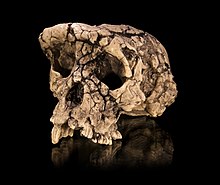Hominins
| Hominins Temporal range: 5.4–0 Ma |
|
|---|---|
 |
|
| Skull of Sahelanthropus tchadensis, described as the earliest member of the hominin line, but this is debated | |
| Scientific classification | |
| Kingdom: | Animalia |
| Phylum: | Chordata |
| Clade: | Synapsida |
| Class: | Mammalia |
| Order: | Primates |
| Suborder: | Haplorhini |
| Family: | Hominidae |
| Subfamily: | Homininae |
| Tribe: |
Hominini Gray, 1825 |
| Type species | |
|
Homo sapiens Linnaeus, 1758 |
|
| Subtribe | |
†Sahelanthropus
†Orrorin
Panina
†Australopithecina
Hominina
The Hominini is a taxonomical tribe of the subfamily Homininae; it comprises three subtribes: Hominina, with its one genus Homo; Australopithecina, comprising at least three extinct genera (see inset at bottom right); and Panina, with its one genus Pan, the chimpanzees (see the evolutionary tree below). Members of the human clade, that is, the Hominina, including Homo and those species of the australopithecines that arose after the split from the chimpanzees, are called homininans. Not all homininans are directly related to the emergence of early Homo. A modern cladogram is given by
Hominina (homininans)
For each clade it is indicated approximately when newer extant clades emerged. Some (older) texts will refer to Homonini as the Hominina branch.The subtribe Hominina is the "human" branch; that is, it contains the genus Homo exclusively. Researchers proposed the taxon Hominini on the basis that the least similar species of a trichotomy should be separated from the other two. The common chimpanzee and the bonobo of the genus Pan are the closest living evolutionary relatives to humans, sharing a common ancestor with humans about four to seven million years ago. Research by Mary-Claire King in 1973 found 99% identical DNA between humans and chimpanzees; later research modified that finding to about 94% commonality, with some of the difference occurring in noncoding DNA.
...
Wikipedia
